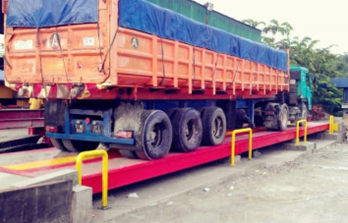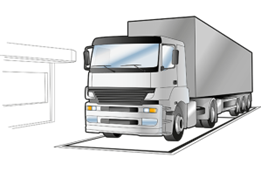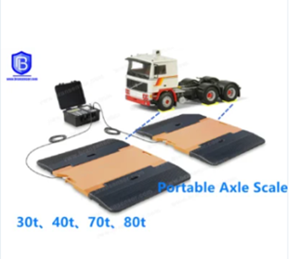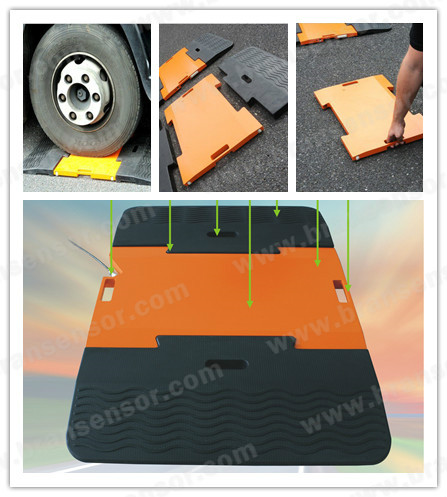 Force Sensor
Force Sensor
 Load Cell
Load Cell
 Torque Force Sensor
Torque Force Sensor
 Multi-axis Force Sensor
Multi-axis Force Sensor
 Piezoelectric Force Sensor
Piezoelectric Force Sensor
Truck scales are important to the trucking business, and drivers need to know how they work. Anyone traveling on highway is likely to see semi-trucks and other large vehicles take the “weigh station” exit. This is where their heavy loads are measured by truck scales in order to maintain safety on the road.
How do truck scales work? Truck scales work by measuring weight through mounted levers connected to a balance mechanism or through sensor load cells that deliver information to electronic equipment. These concrete or steel scales are designed to weigh large trucks and commercial vehicles, while either in motion or stopped.
Trucking is considered one of the most dangerous jobs, and freight weight is a significant factor when it comes to safety. Truck scales are vital in protecting truck drivers, fellow vehicles, and road conditions. Knowing how these scales work and ways to improve the process benefits trucking businesses and their drivers.

How Truck Scales Work
Truck scales are generally made of steel and/or concrete and mounted with a ramp or pit. With a ramp, the weighing mechanism is located below the incline and trucks are measured as they ascend. With a pit, trucks remain level with the road surface and the weighing mechanism is located in the trench. Either way, truck scales can weigh enormous vehicles multiple times a day.
The Trucks
Commercial vehicles and large non-commercial trucks weighing over 10,000 pounds are required to stop for weight measurement at designated locations. When trucks approach established scales, they may be required to stop so each axle (bar that attaches wheels) is weighed individually, or the stopped truck may be weighed as a whole. Some truck scales are advanced such that vehicles can be weighed as they are moving, allowing for greater efficiency.
The Scales
Technology has greatly impacted how truck scales work. Previously, these scales operated with levers and balance beams to measure weight displacement. Most modern truck scales are operated with load cell systems. These systems combine sensors, electric current, and technology to measure truck weight:
Load cells: Load cells are force gauges, made of steel or concrete, with attached strain gauges.

Strain gauges: Strain gauges are made up of wires that transmit a small electric current. As weight triggers the load cell, the strain gauge wires are changed, as is the current running through them.
Sensor box: These wire changes are transmitted as signals from each load cell to a sensor box that measures the deviation in the current.
The truck scale calculates the amount of weight based on this process.
The Results
Weight readings are recorded at individual weigh stations set up along highways and run by individual states. Truck scale software is utilized to report data and print tickets if needed. These software programs also allow trucking businesses to track shipments and freight weight more effectively.
Once truck drivers have navigated the scale and complied with all weigh station requirements, they can continue their route until the next station where they repeat the entire process.

Methods of Weighing Trucks
Truck scales have improved in accuracy, safety, and efficiency. The average time drivers currently spend weighing their trucks is between three and five minutes. Though experts estimate this weigh time results in a nearly ten-dollar productivity loss, this is significantly lower due to upgraded truck-weighing methods.
There are three primary methods of weighing trucks:
1.Weigh-In-Motion (WIM)—this method is the most streamlined for truck drivers. Axle weight is calculated in total as the truck driver passes over a sensor pad. This is extremely efficient for drivers since they do not have to stop their vehicles to be weighed.
2.One-Stop—this method is efficient in that a truck can be weighed as a whole; however, the vehicle must be fully stopped. Overall weight is calculated with multiple scales connected to one sensor box that adds measured axle weights.
3.One-Axle—this is the least efficient method for weighing trucks. With this system, a driver must have each axle weighed by stopping on the scale multiple times, for each set of wheels. The axle weights are then added together for the total measurement.
Importance of Truck Scales
Without truck scales, the business of transporting goods (particularly across state lines) would be chaotic and unregulated. This would increase risk for truck drivers, law enforcement, fellow motorists, and commerce.
Truck scales are important for three main reasons:
l Road safety—each state sets safety regulations for its roads. If a truck exceeds the established weight (generally over 80,000 pounds), then roads and highways are at risk for damage. This results in dangerous conditions for other drivers and costly repairs for transportation departments.
l Revenue—states collect taxes on transported goods, generally based on freight weight. Truck scales allow for accurate reporting of freight weight so that tax revenue is proportionate and recorded.
l Driver safety—truck drivers often forego driving breaks, and even sleep, in order to deliver freight on time. Overloaded trucks add to such risk with reduced vehicle performance and possible unsecured cargo. Truck scales monitor proper freight weight for safe driving conditions. Drivers and trucking businesses can be fined if freight weight exceeds regulated amounts.
Weigh Stations
Individual states decide on weigh station locations, often near borders. In addition, individual state governments set weigh station regulations. This can result in different requirements for drivers within a single transport run. Trucking businesses can find these state regulations online.
Each weigh station contains truck scales. Initially, truck weight was measured and taxes were collected at these stations. Today, trucks are still weighed and from being recorded. However, the primary function of weigh stations is safety regulation.
While truck scales are in use, drivers are often required to show paperwork and permits. In addition to being weighed, vehicles are subject to inspection at weigh stations—particularly the brakes and wheels.
Some station areas will even assess the condition of drivers and whether they appear competent to continue their route. This can cause significant delays for drivers, yet compliance is required.
Weigh stations are often managed by state departments of transportation and overseen by highway patrol or state police. Policy can change quickly and without notice. Therefore, truck drivers are well-served in researching individual state information for every route. This system creates a balance for trucking businesses, drivers, and law enforcement.
Tipping the Scale
Truck drivers are under great pressure to transport their goods intact and on time. Often delivery deadlines don’t account for traffic, detours, road conditions, or other obstacles. This includes stopping for truck scales.
Not surprisingly, truck drivers have learned ways to beat the system by avoiding weigh stations and scales as a means of saving “stopped” time. For example, phone apps have been developed to alert drivers to weigh station operation hours, allowing them to time their passing when the station is closed.
However, some trucking businesses can provide their drivers with “pass” devices that allow them to occasionally bypass weigh stations in order to expedite routes, without breaking the law.
Drivers may also come across unexpected checkpoints set up by law enforcement with portable truck scales. These portable scales can be set up on nearly any surface and are comparable with their stationary counterparts in weight accuracy. Therefore, trying to tip the truck scales by avoiding them altogether is unwise.
Ultimately, it’s best for drivers to comply with scale, weight, and road guidelines to ensure overall security.
Scale Balance
As technology and transportation advances, so will improvements in truck scales and the process of hauling freight. For now, trucking businesses and drivers must balance efficient delivery of goods, safety of those on the road, and state transportation regulations. Truck scales are essential in preserving this balance and knowing how they work is key.
